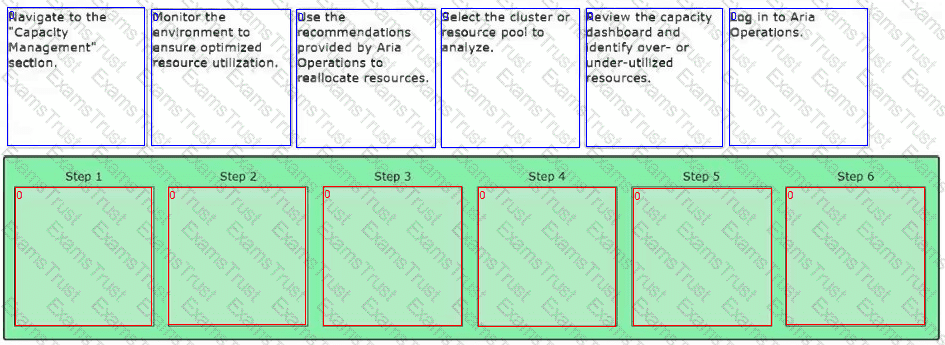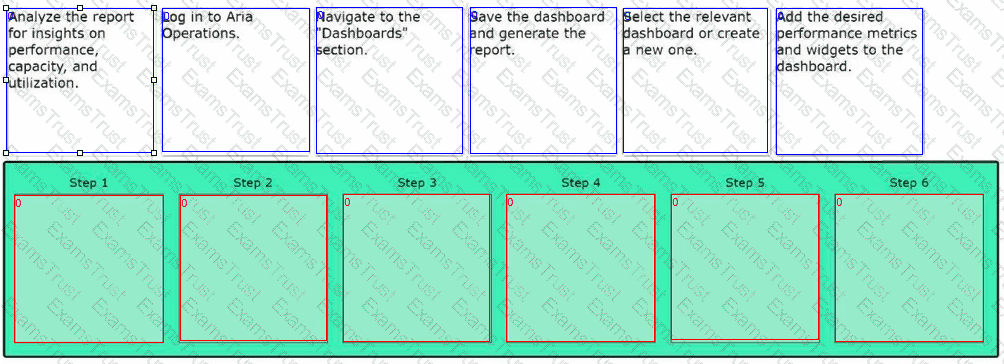An organization wants to centralize its VM templates, ISO images, and scripts to streamline deployment processes across multiple sites using Content Libraries.
Which three steps are required to create a new Content Library? (Choose three.)
An administrator is using VMware Aria Automation to automate the provisioning of virtual machines in their VMware Cloud Foundation environment. They notice that the automation workflows are failing frequently and want to troubleshoot the issue.
What step should the administrator take in VMware Aria Operations for Logs to diagnose the cause of the automation workflow failures?
An organization is implementing a downtime avoidance solution and wants to ensure continuous availability of applications across separate sites that are connected via a high bandwidth/low latency link.
Which two VMware Cloud Foundation components support this capability with stretched clusters? (Choose two.)
DRAG DROP
Put the following steps in the correct order to optimize resource allocation using Aria Operations.

An administrator has been tasked with expanding an existing VMware Cloud Foundation environment by adding a new workload domain. The environment currently has one management domain and one VI workload domain.
What options are available to the administrator for deploying NSX in the second VI workload domain?
An administrator is deploying a new VMware Cloud Foundation (VCF) environment. After uploading the completed Deployment Parameter Workbook, the validation task fails and an error message is displayed within the VMware Cloud Builder GUI.
Which log file can the administrator use to identify the cause of the validation error?
What is the primary benefit of using VMware vCenter Content Libraries?
An administrator is troubleshooting a high CPU usage issue of the SDDC Manager VM. Access to SDDC Manager UI is exhibiting degraded performance.
What two steps should the administrator take to diagnose the issue? (Choose two.)
An organization is integrating VMware vCenter with Active Directory (AD) to streamline user authentication. As part of this process, the administrator needs to add AD as an identity source in vCenter.
Which three steps must be performed to successfully add AD as an identity source? (Choose three.)
An administrator is tasked with enabling Workload Management (vSphere Supervisor) on a VMware Cloud Foundation (VCF) workload domain using the SDDC Manager UI.
Which three are prerequisites for enabling Workload Management? (Choose three.)
Which two SDDC Manager operations can be executed on an NSX Edge cluster after it has been deployed? (Choose two.)
An organization requires granular control over vCenter permissions and they need to assign roles to specific user groups.
Which three steps must be followed to assign roles to users or groups in vCenter? (Choose three.)
An administrator can set resource limits and container defaults on a vSphere Namespace.
Which three resource limits can be set? (Choose three.)
Which two operations can be completed in the SDDC Manager UI on an NSX Edge cluster after it has been deployed into a workload domain? (Choose two.)
An administrator is responsible for maintaining a VMware Cloud Foundation (VCF) instance. The administrator has been tasked with scaling the CPU and RAM resources of a virtual machine.
Which three configuration limitations must the administrator consider when completing the task? (Choose three.)
While preparing to enable Application Virtual Networks (AVNs) and deploying Aria Suite components, an administrator plans to deploy an NSX Edge cluster.
What is a requirement for deploying the NSX Edge cluster?
What are three prerequisites for deploying an NSX Edge cluster in a VMware Cloud Foundation solution? (Choose three.)
What is the impact of consolidating snapshots on a virtual machine?
An administrator needs to delete and re-deploy an NSX Edge cluster that was originally deployed from SDDC Manager and has downloaded the edge cleaner tool.
Where should the administrator run the tool to complete this task?
An administrator has deployed a new VI Workload Domain and must deploy a Kubernetes cluster on the vSphere Supervisor.
Which three steps should be followed to successfully deploy the Kubernetes cluster? (Choose three.)
A Cloud Administrator has been tasked with verifying all of the prerequisites are in place prior to deploying VMware Aria Suite Lifecycle. The following information has been provided for the Aria Suite Lifecycle implementation: hostname: lcm domain: vcf.company.com
IP address: 10.0.0.150 /24 -
IP gateway: 10.0.0.1 -
Which three items must the Cloud Administrator ensure are available prior to deploying VMware Aria Suite Lifecycle? (Choose three.)
An administrator is enabling VMware's Virtual Machine Encryption for an existing VMware Cloud Foundation (VCF) Workload Domain in order to meet their organization's compliance regulations.
Which three steps should the administrator take to complete this task? (Choose three.)
Following an update to the Information Security policy, an administrator has been reviewing the status SSL certificates within the VMware Cloud Foundation (VCF) solution.
The new Information Security Policy states:
All SSL certificates must be generated and signed from the shared Microsoft Certificate Authority (CA).
The administrator has discovered the following:
All Aria Suite Components already use CA-signed Subject Alternate Name (SAN) SSL certificates.
All other VCF-based SSL certificates are either self-signed or generated using the VMware Certificate Authority (VMCA).Which three steps must the administrator take to ensure the VCF solution remains compliant and managed by SDDC Manager? (Choose three.)
DRAG DROP
Arrange the steps in the correct order to generate a performance report in Aria Operations.

Which three tasks are performed by Cloud Builder during the bring-up process of a VMware Cloud Foundation solution? (Choose three.)
An administrator is tasked with deploying a new VMware Cloud Foundation (VCF) instance. The management domain is designed to be created with three virtual distributed switches (VDS) configured as follows:
VDS1 - used for management and vMotion traffic
VDS2 - used for vSAN traffic
VDS3 - used for NSX Overlay traffic
What action would the administrator take to deploy the designed configuration?
A Cloud Administrator has been tasked with verifying all of the prerequisites are in place prior to deploying VMware Aria Suite Lifecycle. The following information has been provided for the Aria Suite Lifecycle implementation:
hostname: lcm
domain: vcf.company.com
IP address: 10.0.0.150/24
IP gateway: 10.0.0.1
Which two items must the Cloud Administrator ensure are available prior to deploying VMware Aria Suite Lifecycle? (Choose two.)
DRAG DROP
Match each networking issue with the corresponding troubleshooting step.

An organization is looking to streamline its IT service delivery by automating the deployment of applications and infrastructure across its hybrid cloud environment.
Which VMware Aria Suite component should they use?
A VMware Cloud Foundation administrator notices that the SDDC Manager dashboard shows an alert indicating that one of the ESXi hosts in their workload domain is in a Not Responding state.
What is the first troubleshooting step that should be performed to resolve this issue?
When configuring a new port group on a Virtual Distributed Switch (VDS), what is the purpose of setting a VLAN ID?
An organization needs to perform maintenance on a specific host in a vSAN cluster. An administrator is required to put the host into maintenance mode whilst ensuring that all VMs in the cluster remain accessible.
Which three steps should the administrator take to correctly set a vSAN host into maintenance mode? (Choose three.)
What three steps are required to commission a new host into the SDDC Manager inventory? (Choose three.)
An administrator has been tasked with adding a new VI workload Domain to an instance of VMware Cloud Foundation (VCF).
The administrator only has two prepared ESXi host servers showing in SDDC Manager.
The new VI Workload Domain must use vSphere Lifecycle Images.
Which three supported principal storage options are available to the administrator when configuring the new VI Workload Domain? (Choose three.)
An Administrator is configuring the network within their VCF management domain in preparation to deploy VMware Aria Suite Lifecycle.
What are the two types of virtual networks that the Administrator could configure to support the deployment? (Choose two.)
After a scheduled maintenance window, users report that they are unable to access the vCenter Server. The administrator notices that the vSphere Client is not responding.
What step should the administrator take to troubleshoot this issue?
An administrator is tasked with troubleshooting an issue where some VMs are not appearing in the vCenter inventory after a recent migration to a new vSphere environment.
Which two components should the administrator examine to resolve this issue? (Choose two.)
Which vSphere component is essential for providing persistent storage to Kubernetes workloads deployed on IaaS Control Plane?